
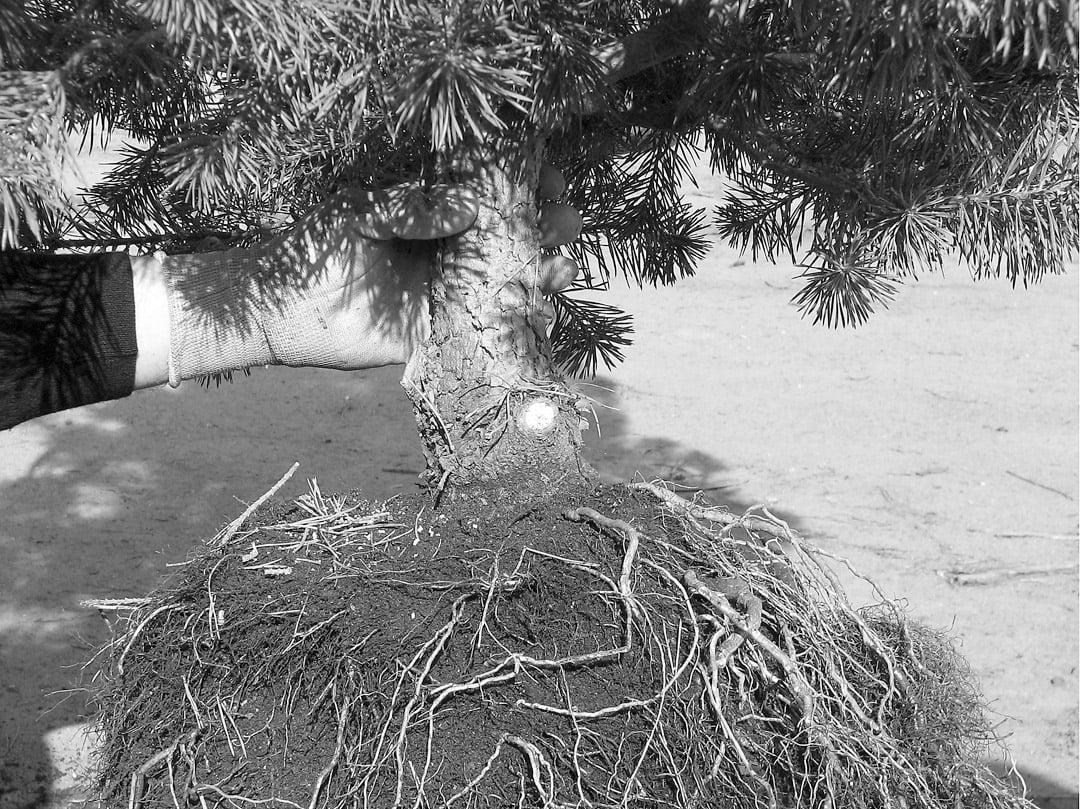
Contributor
- Topics: Archive
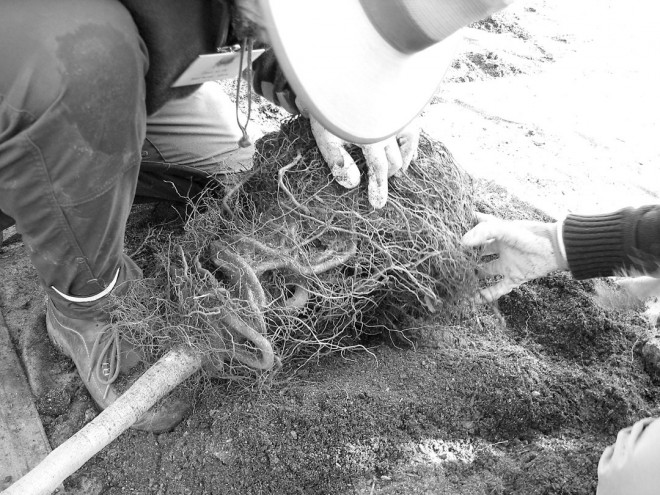
Canopy is a Palo Alto-based, non-profit tree advocacy organization. In January and February 2007, the organization directed the planting of nearly 500 fifteen-gallon trees along Highway 101 in East Palo Alto, California, in a long-term pilot project that will be periodically monitored to determine the general levels of tree performance.
Soundwalls of poured concrete or cement block have proliferated along the West’s freeways in recent years. In East Palo Alto, twelve-foot high walls separate US Highway 101 from the residential neighborhoods of this community on the San Francisco Peninsula. The town’s residents, working with city staff, identified planting sites along the freeway that would benefit from tree planting; most of the sites were litter-strewn strips at the base of the soundwalls.
The situation was less than ideal for planting trees. Five different overhead powerline configurations, coupled with challenging soil conditions left by the construction of the walls, required specifying a variety of tough, drought-adapted tree species. Canopy selected both unusual and commonly planted trees, including primarily evergreen species native to California or adapted to the region’s mediterranean climate.
One of the surprising challenges proved to be locating good container-grown stock. The biggest problem was the character of the root balls; girdling roots threatened the ability of the trees to properly establish once planted. In addition, the trees often had excessive soil on top of their roots inside the containers. Dave Muffly, an ISA board-certified master arborist in Palo Alto, noted large variations in container stock rootball quality, both within and among larger commercial nurseries in central California, indicating a need for greater quality control in the green industry. Fortunately, many of the trees installed required little or no attention, especially those that had been secured in late summer, well before the spring planting season when nursery stocks typically become more limited.
To correct these basic defects in the roots of the containerized trees, volunteers performed hundreds of hours of pre-installation rootball treatment. Led by Dave Muffly, Canopy organized weekend events where residents from the local area employed common-sense techniques to prepare the rootballs of the 467 fifteen-gallon trees for planting along the soundwall. Muffly and Canopy trained the volunteer group in proven rootball massage and girdling root mitigation techniques, demonstrating slightly different techniques for each tree species depending upon the rooting pattern observed on a sample rootball. These methods reduce major root system defects created by improper nursery tree containerization. According to anecdotal reports, trees so treated exhibit better growth performance than non-treated trees.
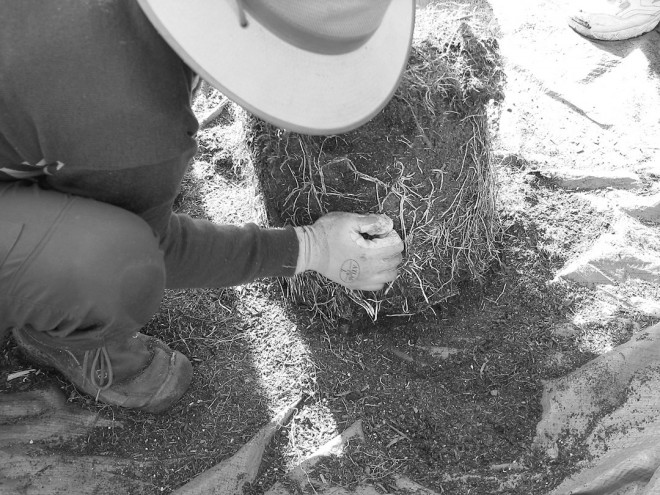
The Techniques
The general techniques involve, first, establishing the primary buttress roots by pulling away excess soil around the trunk until a good trunk flare and larger diameter major roots are encountered. My own reaction to this primary step, during a recent training, was that we were removing too much soil from the upper portion of each rootball. My skepticism was unfounded, however, as I watched Dave remove as much as eight vertical inches of soil from rootball after rootball, reestablishing the original soil grade around the major buttress roots that were buried well below the nursery’s soil level in each fifteen-gallon container.
It appears that nurseries routinely pot up smaller plants into ever-larger containers without regard for the original grade. This often results in a tree with numerous small-diameter adventitious roots emanating from the trunk above the major buttress roots. In other cases, roots have grown up into the soil placed over the original root flare, often girdling the trunk. These roots, if not exposed through soil removal and careful rootball treatment, can grow as much as twelve inches or more above the original root crown, and are easily mistaken for the primary buttress roots.
The second step treats the primary buttress roots, the circling roots around the sides of the rootball, and the bottom of the rootball, to recreate a natural radial growth pattern. This step’s purpose is to establish a rooting pattern that would favor normal root development and tree health, and encourage the roots to grow into the native soil outside the initial planting hole. Any primary buttress root girdling the trunk of the tree or exhibiting a bend of 90° or greater in any direction was cut at the trunk or at the bend using a professional pruning shear. It is critical to understand that any root cut, like any branch cut along its length, will sprout and grow in the same direction the root/branch was growing at the point of the cut.
After we completed the rootball treatment process and pruned the girdling roots, each rootball was returned to its container and covered with soil to the level of the original buttress roots. The soil was then firmed and the trees set aside to await planting.
These activities were performed in January and February 2007—a period normally experiencing heavy rainfall. Last year’s conditions were drier and warmer than normal. The trees were quickly planted in the ground to minimize soil moisture stress. In preparation for planting, a robust irrigation system was installed; this included buried PVC pipe coupled to quarter-inch in-line emitter tubing. Wide planting holes were dug with a small, narrow backhoe. No soil amendment was used. Contractors responsible for planting the trees were trained to plant them correctly, so that the rootballs were installed slightly above the surrounding grade.
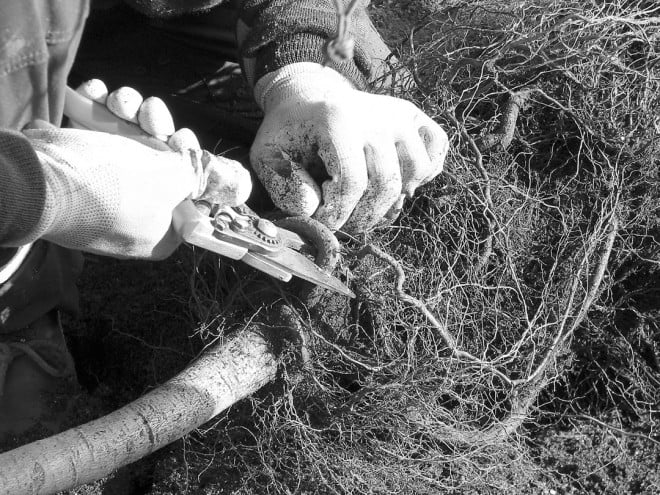
Special Conditions
In some cases, roots were so girdling and bound up against the trunks of the trees that they could not be removed. These roots were experimentally severed with pie-shaped notch-cuts in the hope that subsequent root growth would follow a natural radial pattern outward toward the edge of the planting pit.
Specimens of Scots pine (Pinus sylvestris) obtained for this project had entire branch whorls emanating from below the soil level in the containers. In such cases, we first removed the lowest whorl of branches above the soil line to clear an area of the lower trunk so that we could get a handhold on the tree. We then proceeded to dig out the branch whorl located below the soil level and remove it entirely. At this point, we had removed approximately six to eight vertical inches of soil from each tree’s container and still had not reached the primary buttress roots, indicating that the nursery had potted up the trees using far too much soil. At times, the original buttress roots were not exposed until we had excavated eight to ten inches or more below the container’s soil level. By methodically massaging the upper surface of each rootball and severing small-diameter adventitious roots, we were usually able to find the primary buttress root elevation and reestablish the appropriate grade.
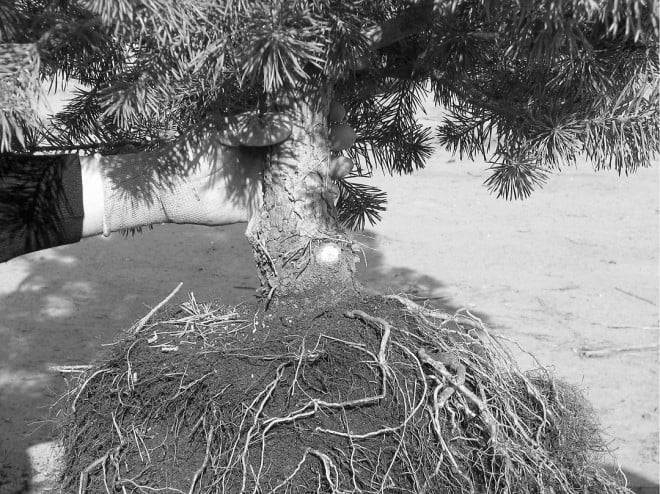
A Pilot Project
The project team expects rootball-treated trees to perform better over the long term compared to trees transplanted directly into the ground without treatments such as removing circling roots, girdling roots, or excess upper rootball soil. The trees in this pilot project will be monitored for vertical growth, survival, and twig density and extension. After almost a full year, only a dozen or so of the original trees have not survived. During surveys in early fall of 2007, all trees were rated on a scale of 0 to 3, with 0 indicating a dead tree. At that time, no additional dead trees were found, and only seventeen earned a rating of 1. The remaining 450 are establishing beautifully, with some trees having grown several feet—in excess of expectations. All are fully expected to provide long-term enhancement to the neighborhoods along the highway. Interestingly, Arbutus ‘Marina’ is proving the most difficult of the species to establish.
Primary funding for this project came from the California Department of Forestry and Fire Protection, through their Proposition 40 “Green Trees for the Golden State” urban forestry funding program.
Canopy, the Palo Alto-based, non-profit tree advocacy organization involved in this tree planting project, can be reached at 650/964-6110, or www.canopy.org.
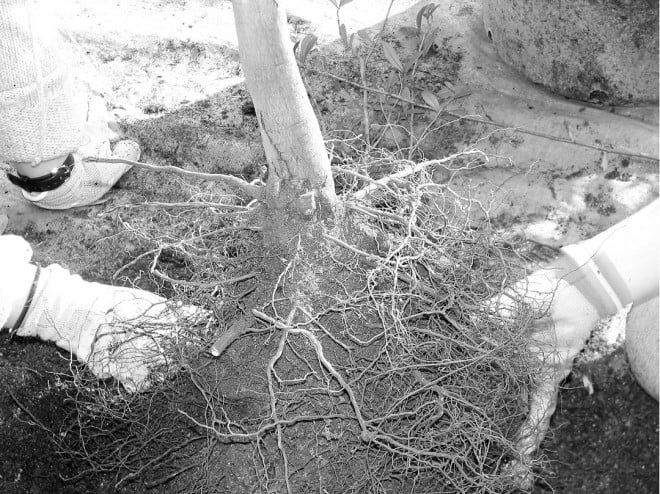
List of Trees Planted in the East Palo Alto Pilot Project:
Arbutus ‘Marina’
Marina madrone
Arbutus unedo
strawberry tree
Lagerstroemia ‘Tuscarora’
Tuscarora crape myrtle
Lagunaria patersonii
primrose tree
Melaleuca linariifolia
flaxleaf paperbark
Olea africana
African olive
Olea europaea
Mediterranean olive
Pinus sylvestris
Scots pine
Prunus lyonii
Catalina cherry
Quercus agrifolia
coast live oak
Quercus arizonica
Arizona white oak
Quercus engelmannii
Engelmann oak
Quercus parvula
dwarf interior live oak
Quercus rugosa
netleaf oak
Quercus suber
cork oak
Quercus tomentella
Island oak
Quercus virginiana
Southern live oak
Tipuana tipu
tipu tree
Tristaniopsis laurina
water gum
Tristaniopsis laurina ‘Elegans’
elegant water gum
Share:
Social Media
Garden Futurist Podcast
Most Popular
Videos
Topics
Related Posts

Ground Up Science for Greener Cities with Garden Futurist Dr. Alessandro Ossola
Spring 2023 Listen to the Podcast here. Alessandro Ossola is a scientist who gets very excited about the challenge of climate change allowing for an

Readying Urban Forests for Climate Realities with Garden Futurist Dr. Greg McPherson
Winter 2023 Listen to the Podcast here. “Going from the mow and blow to a more horticulturally knowledgeable approach to maintaining the landscape. And that

Welcome, Greywater, to the Garden
Summer 2022 Oh, summer: delightful warm air, tomatoes swelling on the vine, fragrant blooms on an evening stroll. When it’s warm and rainless, how is

Big Tree-Data and Big-Tree Data with Garden Futurist Matt Ritter
Summer 2022 Listen to the full Garden Futurist: Episode XV podcast here. We are in an environmental crisis right now in many parts of California








Responses